Sea lettuce lives to be thrashed by salt water. Paper thin, opaque, and a little rubbery, it spends life on the rocks that live in the intertidal zone, constantly battered by the foam that crashes onto the shore—unless, of course, the tide's out.
A soft earthy green enveloped in the curlicues of itself, the algae also known as seaweed cuddles up next to likeminded cousins such as rockweed, a thicker, darker brown algae that kind of looks like a fanned out, soft coral.
Both are edible, and, yes, people do eat them. There are thousands of other seaweeds or macroalgae moving around in ocean water that are also edible. But not all of them are tasty, and you've got to know how to cook them. The ladies at Kelpful—Melissa Hanson, Alycia Drube, and Jules Marsh—have been experimenting with flavors for months now and are eager to share their experience with others.
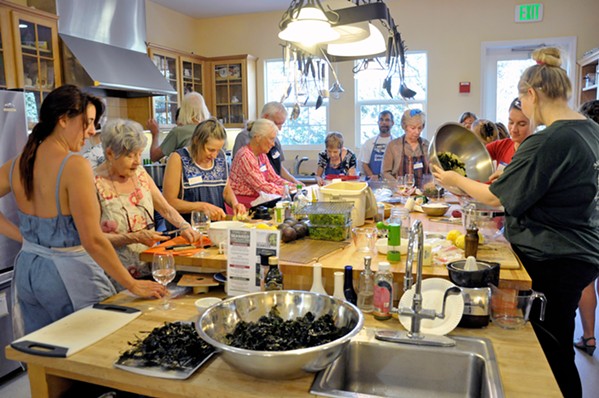
- Photo By Jayson Mellom
- DINNER PREP A group of aspiring seaweed chefs gathers around the Oak Creek Commons kitchen in Paso Robles to learn about how to cook sea veggies from Kelpful, a company hoping to eventually farm seaweed off the Central Coast.
Fifteen to 20 people gather around the Oak Creek Commons kitchen island in Paso Robles on July 28 to attend a Kelpful class and dinner featuring sea veggies hand-harvested from the Estero Bluffs. Dried seaweed sits on every countertop in containers and paper bags, waiting for its designated treatment: to get coarsely chopped, pulverized in a food processor, ripped apart in big chunks. To get blanched, boiled, baked, or toasted.
"The whole point of this class is to show you that there's lots of seaweed out there that you can eat that doesn't come with sushi," Drube says.
The dinner menu tonight includes a compound butter with dried nori flakes; a California sea greens salad incorporating sea lettuce, rockweed, and a couple of other seaweeds; blanched shellfish in white wine and garlic with nori flakes; and pesto with giant kelp (aka macrocystis).
"We hope that everyone will leave here with at least one way you can include sea vegetables into your diet," Hanson says. "I eat a lot of seaweed. ... I put it in my coffee. I eat it on my eggs."
Most of the folks in attendance haven't really eaten much seaweed in their lives but have heard about the health benefits. It's a good source of calcium and iodine, can be rich in protein, and has vitamins and minerals such as vitamin K. Plus, umami. You know, that special "fifth taste" everyone and their designated cooking partners are hell-bent on adding to their dishes.
"More people are starting to eat seaweed across the U.S., but what people are eating is imported from Asia, and the same varieties grow here," Hanson says.
The varieties aren't carbon copies of what grows on the other side of the Pacific Ocean, but they are similar. Versions of nori, wakame, and kombu all grow off the California coast, and you can harvest seaweed for personal use with a standard state fishing license that allows up to 10 pounds per day. The California Department of Fish and Wildlife also issues commercial permits for wild seaweed harvesting; however, the ladies at Kelpful have bigger ambitions than that.
They want to farm it, and they're not the only ones.
Farming seaweed in the ocean isn't new to the world, it's just something that's relatively new to the United States. Over the last decade, seaweed farms have multiplied on the East Coast in New England states like Maine and Connecticut. And while there are several businesses in California that want to farm seaweed off the coast, the state isn't quite there yet.
"The end goal is to put a farm in deeper water and grow it where it wants to grow—and not deplete the environment," Drube tells the crowded kitchen, adding that they are at the beginning stages of what will probably be a long process. "We're somewhat inventing this as we go along with farmers up and down the coast."
What regulations?
Any form of aquaculture in California starts with a lease application and a conversation with State Aquaculture Coordinator Randy Lovell, who works for the California Department of Fish and Wildlife.
He oversees farming in any of the state's water bodies—fresh or marine.
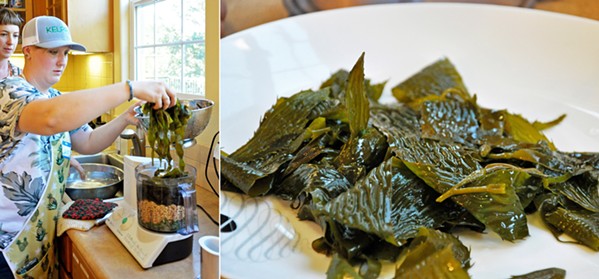
- Photo By Camillia Lanham
- PESTO PESTO Kelpful co-founder Jules Marsh drops recently boiled giant kelp into a food processor to make pesto—and it was delicious.
Although there are a number of shellfish operations growing oysters or mussels in state waters, California hasn't issued a new lease for marine aquaculture in more than 20 years, Lovell said. Part of the reason for that is there haven't been many applications submitted.
"The leases are initiated by growers or applicants that want to apply for them ... . Demand is one factor," Lovell said. "So that kind of begs the question: Why hasn't there been demand? But part of that may have to do with uncertainty about whether or not it will get approved."
Finding a spot in the ocean that could be leased for growing purposes isn't easy. Aquaculture has to compete with other coastal uses, including marine sanctuaries, fishing grounds, administrative kelp beds (which are harvested by boat), tribal interests, shipping lanes and navigation, and homeowner viewsheds.
"There's an awful lot of folks doing a lot of things out there that have to be reconciled," Lovell said. "How much of that calculus figures in for applicants before they actually decide to submit an application, we have no way to gauge."
As far as demand goes, there are three applications for marine aquaculture leases that are being processed at the moment, Lovell said. Approval of those ultimately rests with the California Fish and Game Commission.
Currently, only one lease for farming seaweed exists in California's coastal waters. It belongs to Daniel and Antoinette Marquez and their cosmetics company PharmerSea. The 25-acre site off the coast of Goleta has been continually leased since the 1970s and historically used for seaweed research in conjunction with UC Santa Barbara.
Daniel Marquez said they took on the lease in 2015 or 2016, but changing the name on that lease took a couple of years.
"One of the reasons it took so long for my lease to get renewed with my name on it is that there was nobody else; there was nothing else to compare it to," Marquez said. "We're kind of like grassroots. We're starting this thing."
Although the lease application renewal was granted, Marquez now faces a hurdle known as the California Coastal Commission before he can put a line in the water. He said Coastal Commission staffers have already bounced back his application for a coastal development permit a couple of times. He's working on another round, but said he's frustrated.
"We are the best stewards that you'll possibly have because we need the oceans to be healthy for us to be successful," Marquez said. "The regulations we have here in place in California are good, we just need to figure out some way to get through this process in a reasonable amount of time."
In addition to the time it takes to go back and forth with staffers, applicants then have to wait months to go before the commission.
"That's insane," he said. "You're looking at over three years before you even get a line in the water ... and thousands of dollars."
Karen Gray, who worked as a commission staffer for years and now works for Green Wave, a nonprofit dedicated to spreading the word about ocean farming, compared the back-and-forth between staffers and applicants to a very slow game of tennis.
"Questions lead to more questions," she said.
Although the Coastal Act that created the commission has a provision in it that recognizes aquaculture as an important coastal use, there aren't any guidelines or planning processes in place for it. So the questions that are coming up about growing seaweed—such as the possibility for marine mammal entanglements with the lines used for growing or storm surges that dislodge equipment—have yet to be answered because there's nothing out in the water yet.
There's no yardstick, no precedent.
"I'm curious to see how they rule and what their response is to aquaculture permits coming through, because they haven't really had that," Gray said. "Most of the shellfish farms in California go back to pre-Coastal Act days."
Path forward
Gray has worked for Green Wave for about two years. The goal is to set up a pilot project similar to the ones Green Wave has already established on the East Coast—that can be used to teach aspiring farmers how to grow seaweed and shellfish—but Gray said most of her work for the nonprofit has been dedicated to policy.
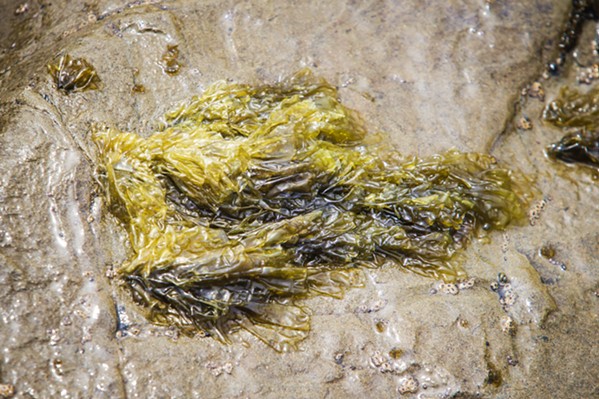
- Photos By Camillia Lanham
- LETTUCE Sea lettuce is a little bit rubbery, edible, and paper thin.
"How much time and money is required to invest before you could even stick a line in the water and grow—that's a huge barrier. And the industry hasn't even kicked off yet," she said. "What's being encouraged really, if there's this huge economic barrier to entry, is that the big corporations will come in."
But, she said, the industry has Coastal Commission buy-in to create guidelines for how to best design projects, which could take at least a couple of years.
Plus, there is some movement. At the moment, a couple of pilot seaweed farming projects are operating on existing leases. Sunken Seaweed worked out a deal with the Port of San Diego to use a quarter-acre of the port's existing lease to demonstrate seaweed farming in San Diego Bay in collaboration with San Diego State University researchers. The port approved the pilot project in April 2018. New Times reached out to Sunken Seaweed founders with questions but didn't get a response back before press time.
Salt Point Seaweed is working with Hog Island Oyster Company in Tomales Bay, using the shellfish operation's lease on a pilot farm with researchers from UC Berkley. In 2017, Salt Point started growing seaweed alongside Hog Island's oysters and monitoring the resulting carbon and nitrogen levels in the water.
The permits granted to the two seaweed companies were for experimental growing and research. Neither is able to sell those farmed sea veggies commercially, Gray said.
"Sometimes I think, 'Oh let's just pack up and head back to the East Coast.' ... But it's really needed here and there's some great interest," Gray said. "There are many farmers in the wings who have come to me and are interested."
More data needs to be collected on what farming seaweed in the ocean actually does to the environment, Gray said, as the industry tries to gain a foothold in California.
"The science is there, but we really need to know more and make it robust," she said.
Not only does research need to be completed on seaweed as a potential food, energy, and fiber source, but for the potential benefits and pitfalls farming it could have on the ocean environment.
A research paper published in 2018 from UC Santa Barbara's Bren School of Environmental Science & Management about the economic feasibility of a seaweed farming industry in Southern California spoke about some of the benefits. Those include absorbing nutrients that are contained in runoff, such as nitrogen, and moderating ocean acidification.
"Seaweeds are net nutrient sinks, which limits their environmental footprint," the paper states. "No pesticide or freshwater inputs are required to grow seaweed in the Southern California [waters]. This is particularly important given the region's limited water resources and frequent bouts with drought."
Farming seaweed, though, isn't relegated to the ocean. A handful of seaweed producers in California are doing it on land in seawater circulation systems. Doug Bush with Cultured Abalone in Goleta has been producing abalone in tanks on dry land for more than two decades.
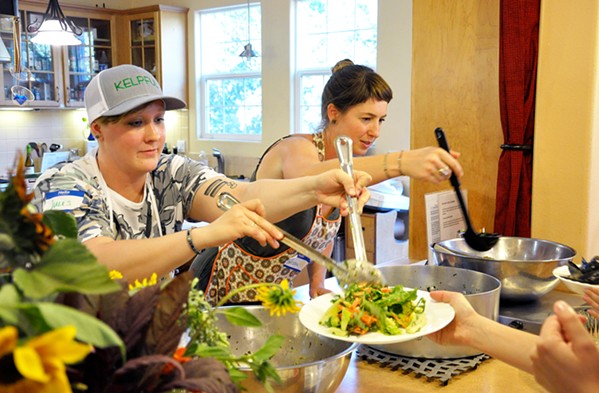
- Photo By Jayson Mellom
- DINNER IS SERVED Jules Marsh (left) and Melissa Hanson from Kelpful dish up a seaweed feast to hungry diners during an educational dinner in July.
The operation harvests kelp from those administrative kelp beds in the ocean and has grown some red seaweeds in tanks alongside the abalone for the past 15 years. Both are food sources for the abalone.
"We also sell those red seaweeds as direct products," Bush said. "To have a fresh local food product that is not reliant on further stress on our freshwater system is kind of a good thing, and it's unique. ... It's something that's kind of emblematic of California agriculture."
Although much of the seaweed Cultured Abalone grows is put back into the shellfish, demand for seaweed is something that's new and growing, he said.
Eventually, Bush said, he's interested in farming seaweed/kelp out in the open water, but the permitting to do a project like that is difficult and a big investment. Not only would he have to get a lease with the Department of Fish and Wildlife and a permit from the California Coastal Commission, the Army Corps of Engineers, Department of Public Health, and a handful of other agencies also need to weigh in.
"The list goes on and on," he said. "There's a lot of projects that are kind of testing the waters, so to speak. There are quite a few people who are interested ... and it's kind of forcing the regulators to come up with a more formulaic method with which to approve."
Plucking veggies
Spencer Marley puts tongs through the steam coming out of a deep pot and moves around some grapestone—a red seaweed—that he just pulled off the rocks at the Estero Bluffs. He's frying it up for Luba Scherschun and John Moreland to try. Behind him, Estero Bay crashes onto the shoreline.
Savory, with a vague taste of bacon, the grapestone is definitely fresh off the beach, complete with a little crunch of sand.
The couple is on a tour with Marley Family Seaweeds at the end of a weekend spent in Paso Robles. Scherschun decided she need a little adventure and is happy she came across this one. After spending about an hour perusing the vegetation attached to partially submerged rocks, wading out into the surf to see what they could find, and plucking their prizes, Marley is now making a ramen for the couple from the seaweed they harvested.
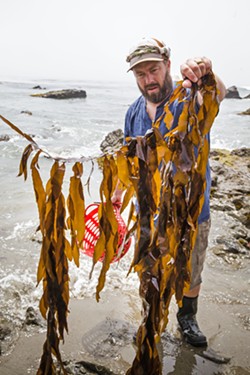
- Photo By Camillia Lanham
- FEATHER BOA Spencer Marley examines what he believes is a type of feather boa, which belongs in the brown algae family. He said, historically, the boa has been used as a good source of fertilizer.
Leaning over a camp stove, Marley adds garlic, ginger, and scallion to the pot with a little bit of avocado oil. Scherschun comments on how good it smells as Marley talks about the benefits of consuming seaweed.
"It's this amazing, flavorful, mineral- and nutrient-rich superfood," Marley says. "The Japanese figured that out thousands of years ago, and we just realized it."
He adds water and seaweed—kombu, rockweed, sea lettuce, and giant kelp—to the pot, bringing it to a boil and dropping in ramen noodles, before dishing it up in bowls with chopsticks for the seaweed adventurers to eat on the beach.
Marley has been taking people on seaweed harvesting adventures for three or four months now. He's had a commercial harvesting permit for about six months, and recently harvested about 300 pounds of seaweed from the Big Sur coastline—his biggest haul yet. He cleaned it, dried it, and will sell it at farmers' markets in North County.
Similar to Marley, the ladies at Kelpful laud the health benefits of consuming seaweed. They believe that it's the next superfood and that farming it in the ocean could help save the planet because of its ability to absorb nitrogen, ammonia, and mitigate ocean acidification.
"I'm on the bandwagon that this is the future of our food system," Marsh tells the crowd gathered around that kitchen island in Oak Commons.
As people fan out to their stations, the ladies start to move around and direct the budding chefs.
"There's supposed to be five carrots. Does this look like five carrots?" one of the helpers at the sea greens salad-making station asks.
The air starts to smell earthy, salty, and a little bit briny. After dinner, Kelpful's founders give a brief presentation on their vision, one that Hanson recounted to New Times during a phone interview. Although Kelpful wild harvested for the dinner, the long-term goal is to grow seaweed in the ocean.
"We're highly motivated to feed our community healthy, low-cost food, and we believe that algae is a way to do that. We believe that a lot of the future of our food system lies in the ocean, specifically with seaweed," Hanson says. "We are participating in the creation of the next economy, an economy that isn't exploitative and extractive and doesn't focus on the economics of growth alone."
But, like all the others leaning into the potential of the seaweed farming industry, Kelpful is still at the very beginning of its quest. The ladies have yet to zero in on a potential leasing site, the first step of many. But they are motivated and moving forward, Drube says.
"We're not trying to bully the system, we're not trying to override the precautions," Drube says. "And we don't want to potentially let bad actors in in the process. We just want to kind of keep the ball rolling." Δ
Reach Editor Camillia Lanham at [email protected].

Comments (2)
Showing 1-2 of 2